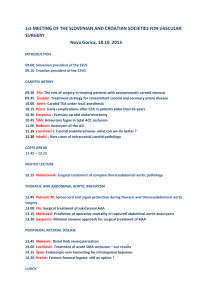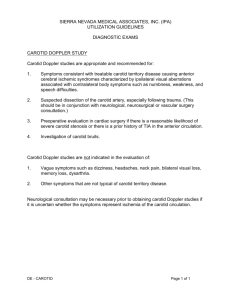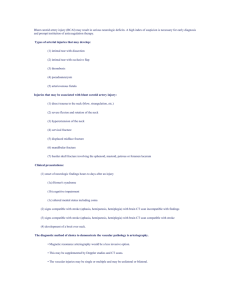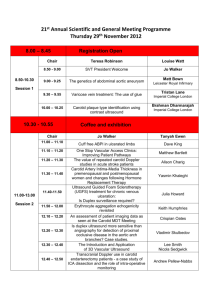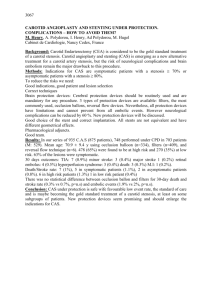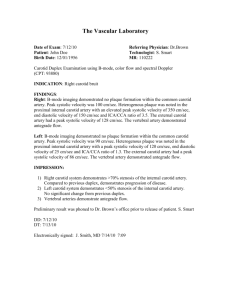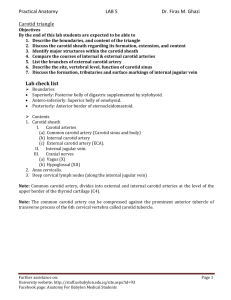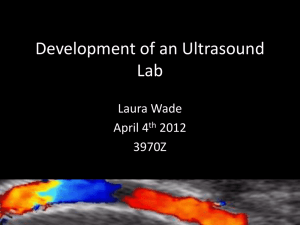full text
advertisement
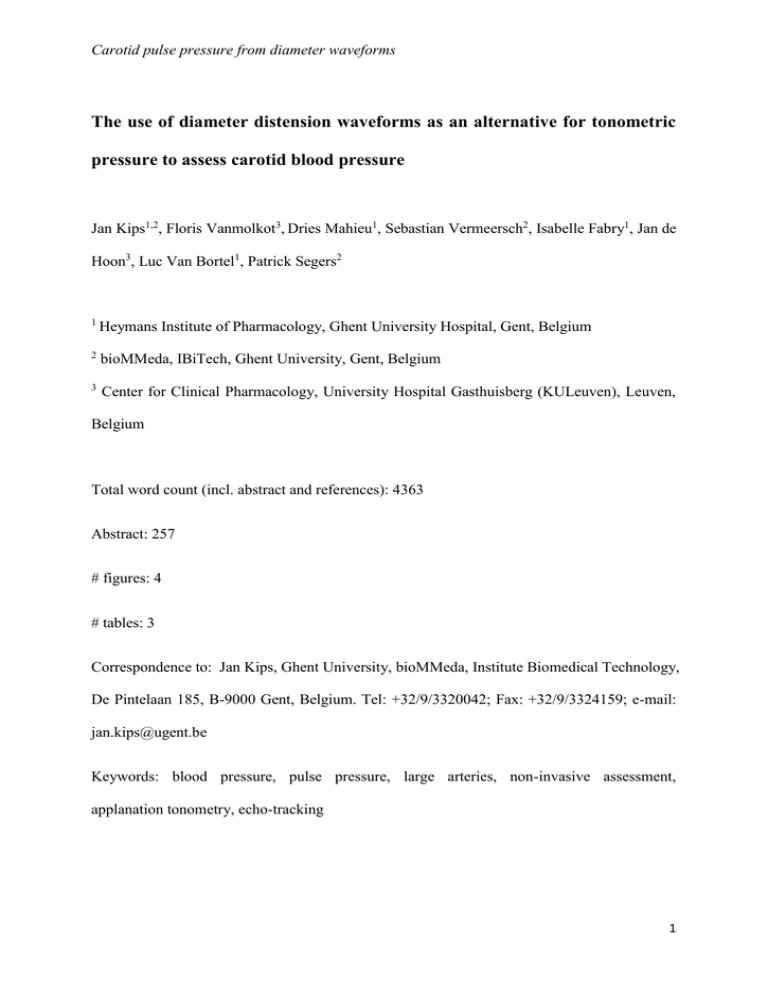
Carotid pulse pressure from diameter waveforms The use of diameter distension waveforms as an alternative for tonometric pressure to assess carotid blood pressure Jan Kips1,2, Floris Vanmolkot3, Dries Mahieu1, Sebastian Vermeersch2, Isabelle Fabry1, Jan de Hoon3, Luc Van Bortel1, Patrick Segers2 1 Heymans Institute of Pharmacology, Ghent University Hospital, Gent, Belgium 2 bioMMeda, IBiTech, Ghent University, Gent, Belgium 3 Center for Clinical Pharmacology, University Hospital Gasthuisberg (KULeuven), Leuven, Belgium Total word count (incl. abstract and references): 4363 Abstract: 257 # figures: 4 # tables: 3 Correspondence to: Jan Kips, Ghent University, bioMMeda, Institute Biomedical Technology, De Pintelaan 185, B-9000 Gent, Belgium. Tel: +32/9/3320042; Fax: +32/9/3324159; e-mail: jan.kips@ugent.be Keywords: blood pressure, pulse pressure, large arteries, non-invasive assessment, applanation tonometry, echo-tracking 1 Carotid pulse pressure from diameter waveforms Abstract Proper non-invasive assessment of carotid artery pressure ideally uses waveforms recorded at two anatomical locations: the brachial and the carotid artery. Calibrated diameter distension waveforms could provide a more widely applicable alternative for local arterial pressure assessment than applanation tonometry. This approach might be of particular use at the brachial artery, where the feasibility of a reliable tonometric measurement has been questioned. The aim of this study was to evaluate an approach based on distension waveforms obtained at the brachial and carotid arteries. This approach will be compared to the traditional pulse pressures obtained through tonometry at both the carotid and brachial arteries (used as reference) and the more recently proposed approach of combining tonometric readings at the brachial artery with linearly or exponentially calibrated distension curves at the carotid artery. Local brachial and carotid diameter distension and tonometry waveforms were recorded in 148 subjects (119 women; aged 19-59 yrs). The morphology of the waveforms was compared by the form factor and the rootmean squared error. The difference between the reference carotid PP and the PP obtained from brachial and carotid distension waveforms was smaller (0.9(4.9) mmHg or 2.3%) than the difference between the reference carotid PP and the estimates obtained using a tonometric and a distension waveform (-4.8(2.5) mmHg for the approach using brachial tonometry and linearly scaled carotid distension, and 2.7(6.8) mmHg when using exponentially scaled carotid distension waves). We therefore recommend to stick to one technique on both the brachial and the carotid artery, either tonometry or distension, when assessing carotid blood pressure non-invasively. 2 Carotid pulse pressure from diameter waveforms Introduction: Central (aortic) blood pressure has gained clinical interest, mainly because some studies have suggested that it has a higher predictive value for cardiovascular events than peripheral (brachial) blood pressure (Agabiti-Rosei et al. 2007;Chirinos et al. 2005;Dart et al. 2006;McEniery et al. 2008;Roman et al. 2007;Safar et al. 2002;Williams et al. 2006). Carotid blood pressure is often used as a surrogate for central aortic blood pressure. An invasive study showed carotid pulse pressure (PP) to differ by only 1.8 mmHg from central aortic PP (Van Bortel et al. 2001) . Unlike mean arterial pressure (MAP), pulse pressure is not constant throughout the large artery tree, but increases towards the periphery (Nichols & O'Rourke 2005;Safar & London 1994) , implying that brachial pulse pressure will generally be higher than aortic or carotid pulse pressure. The latter can be obtained non-invasively following a well-known, linear calibration technique, using applanation tonometry on the brachial and carotid artery combined with brachial oscillometry (Segers et al. 2005;Verbeke et al. 2005) . However, high-quality tonometric readings require a well-trained operator and may be more difficult to perform in elderly and particularly obese patients (Nichols & O'Rourke 2005) . Recently (Vermeersch et al. 2008), two alternative approaches for estimating carotid artery pressures, using a combination of applanation tonometry performed at the brachial artery and either linearly or exponentially calibrated diameter distension waveforms at the carotid artery, were compared to the more common approach of using applanation tonometry on brachial and carotid artery. Using calibrated diameter distension waveforms instead of tonometric waveforms avoids the technical difficulties and necessary operator skills associated with applanation 3 Carotid pulse pressure from diameter waveforms tonometry (Van Bortel et al. 2001). The assessment of diameter distension waveforms of superficial arteries can be performed accurately by ultrasound wall tracking algorithms (Hoeks et al. 1990;Hoeks et al. 1997;Rabben et al. 2002) which requires less training and can more easily be performed in obese patients. These alternative approaches, however, still rely for calibration on tonometry readings performed at the level of the brachial artery, of which the feasibility of performing a reliable tonometric measurement has been questioned recently (O'Rourke, Adji, & Hoegler 2005;O'Rourke & Takazawa 2009b). It is the aim of this study to evaluate a methodology for non-invasive estimation of carotid pulse pressure based solely on diameter distension waveforms obtained at the brachial and carotid arteries. The results of this approach will be compared to the pulse pressures obtained through tonometry at both the carotid and brachial arteries and to the more recently proposed approach of combining tonometric readings at the brachial artery with linearly or exponentially calibrated diameter distension curves at the carotid artery. As an intermediary step, the morphology of brachial and carotid tonometry and distension waveforms will be compared and the mean arterial pressure (MAP) will be computed using either tonometry or distension curves. 4 Carotid pulse pressure from diameter waveforms Methods: Study population Brachial (BA) and common carotid artery (CCA) distension (D) and tonometer (T) waveforms recorded for two previous studies were used (de Hoon et al. 2003;Vanmolkot, Van Bortel, & Hoon 2007). A total number of 148 subjects were selected, none of whom had a history of cerebrovascular or cardiovascular disease, arterial hypertension (>90/140 mmHg), diabetes mellitus, hyperlipidaemia (total cholesterol >6.5 mmol/l), or were currently pregnant or lactating. Subjects on regular use of vasoactive drugs were excluded. Subjects were allowed 10-15 min of rest in a temperature controlled environment before the examinations. Measurement of local pressure and distension Brachial oscillometric blood pressure was measured using either an Omron 705IT ( OMRON Healthcare, Hoofddorp, The Netherlands; 100 subjects), either a Dinamap 950 (Critikon Inc, Tampa, Florida; 48 subjects). Applanation tonometry was performed using a Millar pen-type tonometer (SPT 301, Millar Instruments, Houston, Texas) and computer software (SphygmoCor, Atcor Medical, Sydney, Australia). Distension waveforms were obtained with an ultrasound wall tracking system (Esaote AU5 or Scanner 350, Esaote-Pie Medical, the Netherlands). An ultrasound probe holder was used at the brachial artery to ensure that the distension curves were not deformed by the pressure exerted on the probe. Waveform calibration 5 Carotid pulse pressure from diameter waveforms At the brachial artery, both tonometry and distension waveforms were linearly calibrated using SBP and DBP obtained from oscillometry. For each waveform type, MAP was calculated as the arithmetic mean of the scaled waveform. Hence, for each subject, two estimates are given: MAP T obtained from the tonometric waveform, and MAPD obtained using the distension waveform, respectively. At the carotid artery, diameter waveforms were calibrated using a linear and an exponential calibration scheme. Both calibration schemes are based on the assumption that DBP and MAP remain constant throughout the large arteries. In the linear calibration scheme, the diameter waveform is calibrated by assigning the minimum and mean value of the curve to the brachial DBP and MAPT or MAPD, respectively (Van Bortel et al. 2001). For the exponential calibration, an iterative procedure was followed as first described by Meinders et al (Meinders & Hoeks 2004). In brief, the diameter waveforms are scaled assuming an intrinsic exponential relation between pressure and diameter: 𝑝(𝑡) = 𝑝𝑑 𝑒𝑥𝑝 [∝ ( 𝑑2 (𝑡) 𝑑2 𝑑 − 1)], where p(t) is the pressure waveform, d(t) the diameter waveform, pd the diastolic blood pressure, dd the diastolic diameter and the wall rigidity coefficient. An iterative scheme can be followed to calculate based on DBP and MAPT. In summary, by combining brachial and carotid tonometer and distension waveforms, we obtain four different estimates of carotid PP indicated by the following subscripts: (i) PTT: using brachial and carotid tonometer waveforms (considered here as the reference value) (ii) PTDlin: using brachial tonometer and linearly scaled carotid distension waveforms (Vermeersch et al. 2008) 6 Carotid pulse pressure from diameter waveforms (iii) PTDexp: using brachial tonometer and exponentially scaled carotid distension waveforms (Vermeersch et al. 2008) (iv) PDD: using linearly scaled brachial and carotid distension waveforms PTT will be considered as the reference method in further analyses since it is accepted to be the most accurate non-invasive method to assess local pressure (Van Bortel et al. 2001). Waveform comparisons To assess whether scaled diameter waveforms can be used as a surrogate for tonometry waveforms and to investigate the impact of the different calibration methods, two morphological parameters are calculated to quantify the overall agreement between the scaled diameter and the tonometric waves. The root-mean-squared error (RMSE) is a measure of the absolute difference between the scaled diameter and tonometry waveforms and, as such, allows to quantify how closely the values of the waveforms match across the entire waveform. RMSE is calculated between the reference carotid waveform (PTT) and each of the five other approaches (generically called ‘Papprox’ hereafter) as : 𝑅𝑀𝑆𝐸 = √[ ∑𝑛 1 (𝑃𝑎𝑝𝑝𝑟𝑜𝑥,𝑖 −𝑃𝑇𝑇,𝑖 ) 𝑛 2 ]. The form factor (FF) (Chemla et al. 2002) is a measure of how peaked the waveform is, and is defined as the ratio of the difference between the mean and minimum value of the wave and its amplitude (maximal – minimal value): 𝐹𝐹 = 𝑚𝑒𝑎𝑛−𝑚𝑖𝑛𝑖𝑚𝑢𝑚 𝑎𝑚𝑝𝑙𝑖𝑡𝑢𝑑𝑒 , see Figure 1. Unlike RMSE, FF is independent of calibration for the linear calibration scheme, which allows a comparison between carotid distension and tonometry waves, irrespective of which curve was used at the brachial artery. Moreover, the form factors of brachial and carotid curves are important determinants of 7 Carotid pulse pressure from diameter waveforms the carotid pulse pressure, which renders them more relevant for this study than the overall match between two waveforms as expressed by the RMSE-value. Statistical analysis Data are presented as mean (standard deviation). Relative errors in mean and peak pressure are reported with respect to pulse pressure measured at the brachial artery with cuff sphygmomanometry. Correlation between variables was assessed using Pearson correlation coefficients. Effects of gender were assessed using ANOVA analysis. P-values lower than 0.05 were considered as statistically significant. To assess the major determinants of the differences in carotid PP estimates, a stepwise forward multiple linear regression analysis was performed including age, gender, length, BMI and brachial PP as potential factors. Only the factors that were significant in univariate analysis were entered into multivariate analysis. A univariate general linear model was constructed to assess whether the form factor differed between the carotid and brachial artery, and between distension and tonometer waveforms. All analyses were performed using SPSS 15 (SPSS Inc., Chicago, IL, USA). 8 Carotid pulse pressure from diameter waveforms Results: General clinical characteristics of the population can be found in Table 1. Comparing waveforms by form factor When comparing tonometry and distension waveforms at the same location by their form factor, we find a higher FF for distension than for tonometry waveforms at both the brachial and the carotid site (Table 2A). When looking at differences between brachial and carotid artery waveforms, we find brachial FF (both FFD and FFT) to be lower than carotid FF (Table 2A). However, the relation between the form factor of the tonometer and distension waveforms is not different for the carotid and brachial artery, as can be seen in Figure 2. The interaction term between location (brachial or carotid) and technique (tonometer or distension) was not significant (p=0.75) in the general linear model. Additionally, both brachial and carotid FF (both FFD and FFT) were significantly higher in women than in men. This difference remained significant after correction for height and heart rate. MAPD versus MAPT The use of diameter distension waveforms instead of tonometry waveforms to calculate MAP introduces a difference of 6.2% or 2.8(1.8) mmHg. MAPD was higher than MAPT: 88.8(7.8) versus 86.0(8.0) mmHg. There was an excellent correlation between both estimates (R=0.97), but the difference was highly significant (P<0.001), see Figure 3. Carotid pulse pressure 9 Carotid pulse pressure from diameter waveforms Table 2B lists the resulting carotid pulse pressure values for the different approaches, as well as the RMSE values associated with each approach. PDD, the pressure waveform obtained via linearly scaled diameter waveforms at the brachial and carotid artery, yields the carotid PP closest to the reference technique: 40.8 (7.8) mmHg compared to 39.9 (8.7) mmHg for PTT. The difference between both techniques was depending on age only (Table 3). Figure 4 shows the correlation between the reference carotid PP (PPTT) and the value obtained with three other approaches, as well as the corresponding Bland-Altman plots. PTDlin, the approach using brachial tonometry and linearly scaled carotid diameter waveforms yielded the highest correlation (R=0.97) and the smallest RMSE with the reference technique. However, PTDlin underestimates the carotid PP on average by 4.8 mmHg. Discussion: The results from the present study suggest that, when diameter distension waves are used as an alternative to tonometry pressure readings at the carotid and/or brachial arteries, it is recommended to measure diameter distension waves at both the brachial and carotid artery, instead of combining tonometer waves at one artery with distension waves at the other artery. Although previous studies have assessed carotid pressure using only diameter distension waves (Van Bortel et al. 2001) or using brachial tonometry and carotid distension waves (Vermeersch et al. 2008), an approach in which carotid pulse pressure is calculated using brachial and carotid distension curves has not been tested before. Given the reported problems with brachial tonometry, this approach might have clinical relevance. Furthermore, it should be noted that calibrated tonometric curves might not exactly coincide with invasively measured pressure waves, 10 Carotid pulse pressure from diameter waveforms due to limitations inherent to the principle of applanation tonometry. In theory, there should be a constant balance between (internal) blood pressure and applied pressure, i.e. a constant position throughout the cardiac cycle. This creates a problem during peak and late systole where the rebound may induce temporarily an outward motion and, hence, an underestimation of blood pressure. Likewise a pressure overestimation can be anticipated in early systole. Another issue with applanation tonometry is the questioned reliability in obese subjects. The tonometer has to sense through more (fatty) tissue, and the artery cannot confidently be flattened as there is less direct support of bone behind the artery. Brachial and carotid distension waveforms were found to be significantly “flatter” (i.e., having a higher form factor) than the corresponding tonometric waves. The fact that distension waveforms were flatter than tonometric waveforms can be explained by the non-linear pressure-diameter relationship, which blunts at higher pressures (i.e., the vessel distends less with increasing pressure due to the increasing recruitment of collagen fibers in the stretched vessel wall). This non-linear relation between pressure and diameter was the rationale for using an exponential calibration scheme (Meinders & Hoeks 2004). A particular consequence of the difference in “peakedness” between tonometry and diameter-tracings is that the MAP determined from the area under the brachial distension waveform is on average 2.8 mmHg (6.2% of the pulse pressure) higher than MAP obtained via brachial tonometer waveforms. This difference in MAP has an important impact on the differences between the various carotid pressure waves, since each calibration method on the carotid artery is strictly dependent on the (brachial) MAP. Although the two MAP-estimates correlate well, this correlation is highly enhanced by the use of the same (sphygmomanometrically obtained) SBP and DPB to scale the brachial pressure and distension 11 Carotid pulse pressure from diameter waveforms waveforms for each subject. To eliminate this effect, one could compare MAPT-DBP to MAPDDBP. Given, however, the definition of the form factor and the fact that PP at the brachial artery is the same, irrespective the waveform measuring technique, the ‘unscaled’ correlation is nothing but the relation between FFD and FFT at the brachial artery, which is displayed in Figure 2.This correlation is notably lower (R=0.47). When comparing the different carotid pulse pressure values, the difference between PP DD and PPTT is the lowest, being 0.9 (4.9) mmHg or 2.3%. It is even lower than the difference between MAPD and MAPT, which seems to imply that a part of the difference introduced by using a distension waveform at the brachial level is compensated by the second use of a distension waveform at the carotid artery. This can easily be understood when taking into account that 𝐹𝐹 𝑃𝑃𝐶𝐶𝐴 = 𝐹𝐹 𝐵𝐴 𝑃𝑃𝐵𝐴 (Segers et al. 2009). This illustrates that the pulse pressure at the carotid 𝐶𝐶𝐴 artery is determined by the ratio of the brachial and carotid form factor. Therefore, systematic differences in FFBA and FFCCA are partially compensated for. MAP, on the other hand, is determined by the brachial form factor only. When using tonometer curves at both sites, the ratio FFBA/FFCCA is 0.88 (see Table 2A) versus 0.90 when using distension data at both sites, explaining why the difference between PPDD and PPTT is smaller than the difference between PPTDlin or PPTDexp with PPTT, respectively (where the ratio FFBA/FFCCA is 0.78 and 0.92, respectively). Using brachial tonometer and carotid distension waves to calculate carotid pulse pressure (PP TDlin) yielded the estimate with the highest correlation with PPTT, but a considerable underestimation of 4.8(2.5) mmHg when compared to PPTT. This in line with the results of Vermeersch et al., who 12 Carotid pulse pressure from diameter waveforms found the same approach to underestimate PPTT by 6.4 mmHg in a large population of middleaged people (Vermeersch et al. 2008). They found that the underestimation was highly dependent on brachial PP, with increasing underestimation for higher brachial PP. We could confirm this dependency on brachial PP in our population (Table 3), which also explains why our PP TDlin performs somewhat better than in the study of Vermeersch et al., where the average brachial pulse pressure was higher (56.2 vs. 45.2 mmHg). The added value of an exponential calibration scheme for carotid diameter distension waves in combination with brachial artery tonometry is arguable. Although exponential calibration yields a form factor and pulse pressure closer to the reference (FFT and PPTT, respectively), the overall fit between the exponentially scaled diameter waveform and the tonometric reference waveform was poorer than for a linearly scaled diameter waveform (Table 2B). Theoretically, two other –non-reported - approaches to obtain a carotid pressure wave are possible: a first one combining brachial distension curves with carotid tonometry, and a second one using linearly scaled brachial distension and exponentially scaled carotid distension curves. Both methods were tested on the study population, but yielded considerable overestimations of carotid PP: 16% and 25%, respectively (data not shown). One important limitation of this study is the absence of invasive pressure data as a reference to compare the results of the different non-invasive approaches. Furthermore, the limited sample size and age range of our population may hamper the generalizability of our results. A final point of debate is the questioned practical feasibility of brachial applanation tonometry as argued by O’Rourke and colleagues (O'Rourke, Adji, & Hoegler 2005;O'Rourke & Takazawa 2009a) . 13 Carotid pulse pressure from diameter waveforms Figure 3 shows that the relation between the form factor of the tonometer and distension waveforms is not different for the carotid and brachial artery in our population. Since it can be reasonably assumed that the reliability of distension measurements is the same at the carotid and brachial artery, this may suggest that applanation tonometry was acquired with a similar degree of reliability at the brachial and carotid artery and supports the feasibility of applanation tonometry as a reliable technique to obtain non-invasive pressure waveforms at the brachial artery. In conclusion we can state that, when aiming to assess carotid artery pressure non-invasively, the use of linearly scaled diameter distension waves at the brachial and carotid artery introduces only a small error (0.9 mmHg) compared to the gold standard approach with brachial and carotid tonometry curves. Therefore, it is recommended to stick to one technique, either tonometry or diameter distension waves, rather than using a mix of both techniques. Acknowledgements Jan Kips is a recipient of Vlaamse Interuniversitaire Raad research grant VLADOC 2007-0013396. 14 Carotid pulse pressure from diameter waveforms Figure captions Figure 1: Distension waves (black) obtained via echo-tracking are less peaked than tonometric waves (grey). The tonometric wave was normalized, whereas the distension wave was calibrated to have same mean and minimal value as the tonometric wave. Figure 2: Relation between distension and tonometric form factors at brachial and carotid artery: regression plots (A,B) and Bland-Altman plots (C,D). Figure 3: Agreement between the (brachial) mean arterial pressure obtained via tonometric waves (MAPT) and the MAP obtained via distension waves (MAPD). Regression plot (left) and Bland-Altman plot (right). Figure 4: Relation between the different estimates of carotid pulse pressure: regression plots (AC) and Bland-Altman plots (D-F). 15 Carotid pulse pressure from diameter waveforms Tables Table 1: General description of the study population Table 2: 2A:Mean (SD) values of brachial and carotid form factors derived from tonometer (FFT), linearly scaled distension waves (FFDlin) and exponentially scaled distension waves (FFDexp). 2B: Mean (SD) values of PP and RMSE for the different carotid pressure waveforms. PP=Pulse Pressure;RMSE=root-mean-squared error. Table 3: Influence of confounding factors on the difference in carotid pulse pressure estimates. HR=heart rate [bpm]; PPbra=brachial PP from oscillometry [mmHg]. 16 Carotid pulse pressure from diameter waveforms Table 1 subjects (male/female) Mean±SD 148 (29/119) Age [years] 29.6 (10.1) Weight [kg] 66.8 (11.6) Length [cm] 171.0 (7.8) BMI [kg/m²] 22.8 (3.3) SBP [mmHg] 113.2 (9.8) DBP [mmHg] 68.0 (7.1) PP [mmHg] 45.2 (7.4) Heart rate [bpm] 64.4 (9.0) Table 2A brachial FFT mean (SD) 40.0 (3.8) FFD 46.2 (3.3) carotid FFT 45.4 (3.3) FFDlin 51.4 (3.0) FFDexp 43.6 (6.3) 17 Carotid pulse pressure from diameter waveforms Table 2B PP [mmHg] Mean SD RMSE [mmHg] Mean SD PTT 39.9 8.7 PDD 40.8 7.8 5.0 2.1 PTDlin 35.1 7.3 3.5 1.8 PTDexp 42.5 12.7 3.9 2.5 Table 3 SE normalised 0.10 0.16 0.04 -0.32 0.21 0.13 0.02 -0.39 Age + PPbra 0.29 0.09 0.02 -0.36 Age + HR + PPbra 0.34 0.06 0.017 0.24 Age 0.42 0.36 0.04 0.53 Age + HR 0.51 0.21 0.04 0.34 Age + HR + PPbra 0.54 0.18 0.05 0.20 Variable Determinant (cumulative) R² PPDD-PPTT Age PPTDlin-PPTT PPbra PPTDexp-PPTT 18 Carotid pulse pressure from diameter waveforms References Agabiti-Rosei, E., Mancia, G., O'Rourke, M. F., Roman, M. J., Safar, M. E., Smulyan, H., Wang, J. G., Wilkinson, I. B., Williams, B., & Vlachopoulos, C. 2007, "Central blood pressure measurements and antihypertensive therapy a consensus document", Hypertension, vol. 50, no. 1, pp. 154-160. Chemla, D., Hebert, J. L., Aptecar, E., Mazoit, J. X., Zamani, K., Frank, R., Fontaine, G., Nitenberg, A., & Lecarpentier, Y. 2002, "Empirical estimates of mean aortic pressure: advantages, drawbacks and implications for pressure redundancy", Clinical Science, vol. 103, no. 1, pp. 7-13. Chirinos, J. A., Zambrano, J. P., Chakko, S., Veerani, A., Schob, A., Willens, H. J., Perez, G., & Mendez, A. J. 2005, "Aortic pressure augmentation predicts adverse cardiovascular events in patients with established coronary artery disease", Hypertension, vol. 45, no. 5, pp. 980-985. Dart, A. M., Gatzka, C. D., Kingwell, B. A., Willson, K., Cameron, J. D., Liang, Y. L., Berry, K. L., Wing, L. M. H., Reid, C. M., Ryan, P., Beilin, L. J., Jennings, G. L. R., Johnston, C. I., Mcneil, J. J., MacDonald, G. J., Morgan, T. O., & West, M. J. 2006, "Brachial blood pressure but not carotid arterial waveforms predict cardiovascular events in elderly female hypertensives", Hypertension, vol. 47, no. 4, pp. 785-790. de Hoon, J. N., Willigers, J. M., Troost, J., Struijker-Boudier, H. A., & Van Bortel, L. M. 2003, "Cranial and peripheral interictal vascular changes in migraine patients", Cephalalgia, vol. 23, no. 2, pp. 96-104. Hoeks, A. P. G., Brands, P. J., Smeets, F. A. M., & Reneman, R. S. 1990, "Assessment of the Distensibility of Superficial Arteries", Ultrasound in Medicine and Biology, vol. 16, no. 2, pp. 121-128. Hoeks, A. P. G., Willekes, C., Boutouyrie, P., Brands, P. J., Willigers, J. M., & Reneman, R. S. 1997, "Automated detection of local artery wall thickness based on M-line signal processing", Ultrasound in Medicine and Biology, vol. 23, no. 7, pp. 1017-1023. McEniery, C. M., McDonnell, B., Munnery, M., Wallace, S. M., Rowe, C. V., Cockcroft, J. R., & Wilkinson, I. B. 2008, "Central pressure: Variability and impact of cardiovascular risk factors - The Anglo-Cardiff Collaborative Trial II", Hypertension, vol. 51, no. 6, pp. 1476-1482. Meinders, J. M. & Hoeks, A. P. G. 2004, "Simultaneous assessment of diameter and pressure waveforms in the carotid artery", Ultrasound in Medicine and Biology, vol. 30, no. 2, pp. 147-154. Nichols, W. W. & O'Rourke, M. F. 2005, McDonald's Blood Flow in Arteries. O'Rourke, M. F., Adji, A., & Hoegler, S. 2005, "Calibration of noninvasively recorded upper-limb pressure waves", Hypertension, vol. 46, no. 5, p. E15. O'Rourke, M. F. & Takazawa, K. 2009b, Flawed measurement of brachial tonometry for calculating aortic pressure?. O'Rourke, M. F. & Takazawa, K. 2009a, Flawed measurement of brachial tonometry for calculating aortic pressure?. 19 Carotid pulse pressure from diameter waveforms Rabben, S. I., Bjaerum, S., Sorhus, V., & Torp, H. 2002, "Ultrasound-based vessel wall tracking: An autocorrelation technique with RF center frequency estimation", Ultrasound in Medicine and Biology, vol. 28, no. 4, pp. 507-517. Roman, M. J., Devereux, R. B., Kizer, J. R., Lee, E. T., Galloway, J. M., Ali, T., Umans, J. G., & Howard, B. V. 2007, "Central pressure more strongly relates to vascular disease and outcome than does brachial pressure - The strong heart study", Hypertension, vol. 50, no. 1, pp. 197-203. Safar, M. E., Blacher, J., Pannier, B., Guerin, A. P., Marchais, S. J., Guyonvarc'h, P. M., & London, G. M. 2002, "Central pulse pressure and mortality in end-stage renal disease", Hypertension, vol. 39, no. 3, pp. 735-738. Safar, M. E. & London, G. M. 1994, The arterial system in human hypertension, Blackwell Scientific Publications. Segers, P., Mahieu, D., Kips, J., Rietzschel, E., De Buyzere, M., De Bacquer, D., Bekaert, S., De Backer, G., Gillebert, T., Verdonck, P., & Van Bortel, L. 2009, "Amplification of the Pressure Pulse in the Upper Limb in Healthy, Middle-Aged Men and Women", Hypertension, vol. 54, no. 2, pp. 414-420. Segers, P., Rietzschel, E., Heireman, S., De Buyzere, M., Gillebert, T., Verdonck, P., & Van Bortel, L. 2005, "Carotid tonometry versus synthesized aorta pressure waves for the estimation of central systolic blood pressure and augmentation index", American Journal of Hypertension, vol. 18, no. 9, pp. 1168-1173. Van Bortel, L. M., Balkestein, E. J., van der Heijden-Spek, J., Vanmolkot, F. H., Staessen, J. A., Kragten, J. A., Vredeveld, J. W., Safar, M. E., Struijker-Boudier, H. A., & Hoeks, A. P. 2001, "Non-invasive assessment of local arterial pulse pressure: comparison of applanation tonometry and echo-tracking", Journal of Hypertension, vol. 19, no. 6, pp. 1037-1044. Vanmolkot, F. H., Van Bortel, L. M., & Hoon, J. N. 2007, "Altered arterial function in migraine of recent onset", Neurology, vol. 68, no. 19, pp. 1563-1570. Verbeke, F., Segers, P., Heireman, S., Vanholder, R., Verdonck, P., & Van Bortel, L. M. 2005, "Noninvasive assessment of local pulse pressure - Importance of brachial-to-radial pressure amplification", Hypertension, vol. 46, no. 1, pp. 244-248. Vermeersch, S. J., Rietzschel, E. R., De Buyzere, M. L., De Bacquer, D., De Backer, G., Van Bortel, L. M., Gillebert, T. C., Verdonck, P. R., & Segers, P. 2008, "Determining carotid artery pressure from scaled diameter waveforms: comparison and validation of calibration techniques in 2026 subjects", Physiological Measurement, vol. 29, no. 11, pp. 1267-1280. Williams, B., Lacy, P. S., Thom, S. M., Cruickshank, K., Stanton, A., Collier, D., Hughes, A. D., & Thurston, H. 2006, "Differential impact of blood pressure-lowering drugs on central aortic pressure and clinical outcomes - Principal results of the Conduit Artery Function Evaluation (CAFE) study", Circulation, vol. 113, no. 9, pp. 1213-1225. 20

